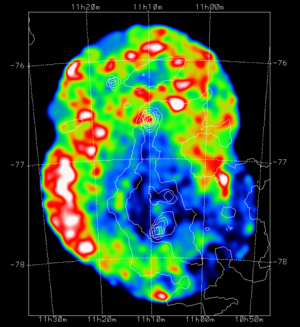蝘蜓座复合体

蝘蜓座复合体包含蝘蜓I、蝘蜓II、和蝘蜓III三个暗星云,是位于本地泡表面的一个大型恒星形成区(SFR)。它几乎塞满整个的蝘蜓座,并且有些区域与苍蝇座、天燕座、船底座和南极座重叠。X射线源的平均密度为每平方度一个X射线源[2]。
蝘蜓I暗星云
[编辑]
蝘蜓I(Cha I)暗星云距离我们大约160秒差距,是距离最近的活跃恒星形成区域之一[3]。它独立于其它恒星形成区,因此较老的前主序星(PMS)不太可能漂移到该领域[3],恒星总数为200-300颗[3]。 Cha I可以进一步分为北云或北区,和南云或主云。
HD 97300发射X射线,照亮反射星云IC 2631,并且是Cha I云中质量最高的成员之一,光谱类型B9V,是一颗没有发射线的赫比格Ae/Be星[3]。

Chaα1是蝘蜓I 暗星云中光谱类型为M8的天体,在1998年被确定为X射线源,因此是发现的第一个发射X射线的棕矮星。
在蝘蜓I恒星形成区有大约70到90个X射线源[4]。乌呼鲁X射线源(4U 1119-77)位于蝘蜓I暗星云中。伦琴卫星于世界时1991年2月9日22:14:47 至2月18日17:59:12和1991年3月6日09:12:19至 13:05:13观测这个X射线源[4]。这个暗星云包含“弱”金牛T星(WTT)和“经典”金牛T星(CTT)[4]。蝘蜓I 的X射线源ROSAT 66位于RA 11h 17m 36.4-37.9s Dec -77° 04' 27-50“,是CTT,蝘蜓I No. T56,又名CTT星HM 32[4]。
1981年1月23日至24日,在爱因斯坦天文台上用成像比例计数器(IPC,Imaging Proportional Counter)观测了蝘蜓I暗星云2.5小时,确定了大约22个X射线源[5]。这些X射线源都没有接近4U 1119-77至8弧分之内。
蝘蜓II暗星云
[编辑]蝘蜓 II包含乌呼鲁X射线源4U 1302–77。它接近 RXJ 1303.1-7706 at RA 13h 03m 04.70s Dec -77° 06' 55.0",一个K7-M0新WTT[2]。蝘蜓II暗星云包含大约40个X射线源[6]。1993年9月10日至17日对蝘蜓II暗星云进行了观察[6]。X射线源RXJ 1301.9-7706,一个新的 WTTS,光谱类型 K1,是最接近4U 1302-77的候选者[6]。
蝘蜓III暗星云
[编辑]"蝘蜓III暗星云似乎缺乏目前的恒星形成活动[7]。"有两个特别突出的星云与这个区域有关。较小的一个通常被称为拇指纹星云(Thumbprint)[8],较大的称为魔爪星云(Talon Nebula)[9]。
扩展定义
[编辑]这个星云有时被向东部延伸[10], 与北部的暗饰带星云(或苍蝇星云)一起,该复合体被称为“苍蝇-蝘蜓座分子云” [11]。

相关条目
[编辑]参考资料
[编辑]- ^ A nursery for unruly young stars. ESA/Hubble Picture of the Week. [4 February 2014].
- ^ 2.0 2.1 Alcala JM, Krautter J, Schmitt JH, Covino E, Wichmann R, Mundt R. A study of the Chamaeleon star forming region from the ROSAT all-sky survey. I. X-ray observations and optical identifications. Astron. Astrophys. Nov 1995, 114 (11): 109–34. Bibcode:1995A&AS..114..109A.
- ^ 3.0 3.1 3.2 3.3 Feigelson ED, Lawson WA. An X-ray census of young stars in the Chamaeleon I North Cloud. Astrophys. J. Oct 2004, 614 (10): 267–83. Bibcode:2004ApJ...614..267F. arXiv:astro-ph/0406529
 . doi:10.1086/423613.
. doi:10.1086/423613.
- ^ 4.0 4.1 4.2 4.3 Feigelson ED, Casanova S, Montmerle T, Guibert J. ROSAT X-Ray Study of the Chamaeleon I Dark Cloud. I. The Stellar Population. Astrophys. J. Oct 1993, 416 (10): 623–46. Bibcode:1993ApJ...416..623F. doi:10.1086/173264.
- ^ Feigelson ED, Kriss GA. Soft X-ray observations of pre-main-sequence stars in the Chamaeleon dark cloud. Astrophys. J. Mar 1989, 338 (3): 262–76. Bibcode:1989ApJ...338..262F. S2CID 121939381. doi:10.1086/167196. hdl:2060/19880002197
 .
.
- ^ 6.0 6.1 6.2 Alcalá JM, Covino E, Sterzik MF, Schmitt JH, Krautter J, Neuhäuser R. A ROSAT pointed observation of the Chamaeleon II dark cloud. Astron. Astrophys. Mar 2000, 355 (3): 629–38. Bibcode:2000A&A...355..629A.
- ^ Yamauchi S, Hamaguchi K, Koyama K, Murakami H. ASCA Observations of the Chamaeleon II Dark Cloud. Publ. Astron. Soc. Jpn. Oct 1998, 50 (10): 465–74. Bibcode:1998PASJ...50..465Y. doi:10.1093/pasj/50.5.465
 .
.
- ^ Lehtinen K, Mattila K, Schnur G, Prusti T. The Thumbprint nebula: The distribution of molecular gas and dust in a regular BOK globule. Astronomy and Astrophysics. 1995, 295: 487–503.
- ^ Chadwick, Stephen; Cooper, Ian. Imaging the Southern Sky. Springer. : 272. ISBN 1461447496.
- ^ Bonne, L.; Bontemps, S.; Schneider, N.; Clarke, S. D.; Arzoumanian, D.; Fukui, Y.; Tachihara, K.; Csengeri, T.; Guesten, R.; Ohama, A.; Okamoto, R.; Simon, R.; Yahia, H.; Yamamoto, H. Formation of the Musca filament: evidence for asymmetries in the accretion flow due to a cloud–cloud collision. Astronomy & Astrophysics (EDP Sciences). 2020-11-26, 644: A27. ISSN 0004-6361. doi:10.1051/0004-6361/202038281
 .
.
- ^ Hacar, A.; Kainulainen, J.; Tafalla, M.; Beuther, H.; Alves, J. The Musca cloud: A 6 pc-long velocity-coherent, sonic filament. Astronomy & Astrophysics (EDP Sciences). 2016-02-24, 587: A97. ISSN 0004-6361. doi:10.1051/0004-6361/201526015
 .
.
